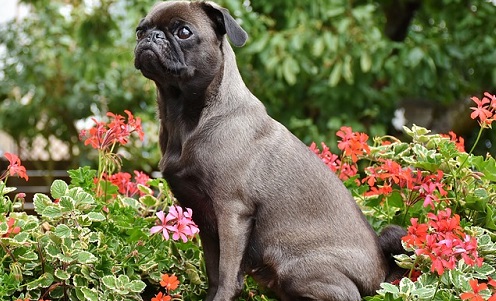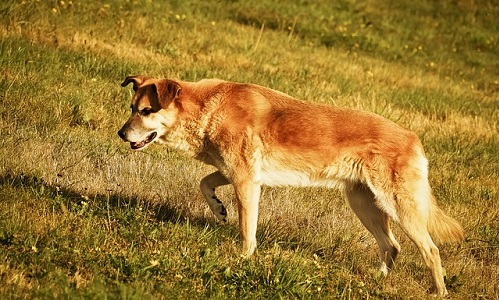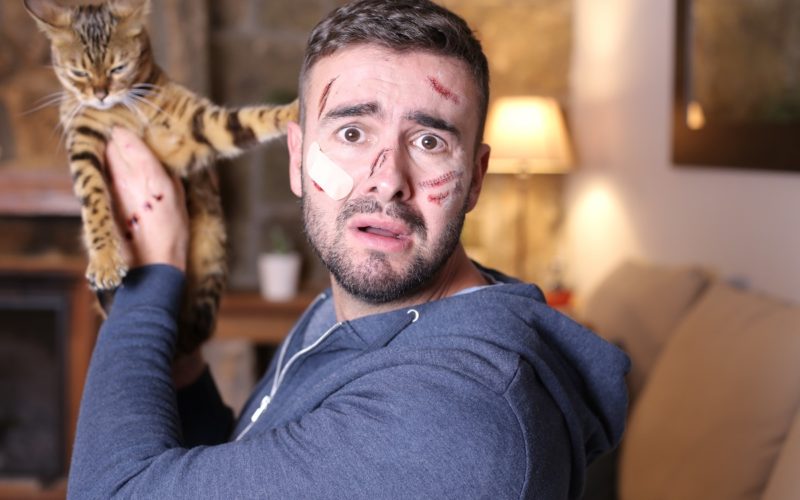If you’ve ever wondered why do dogs have dew claws, as they may just seem like a relatively useless nail on your dog’s paw, dew claws are actually the result of evolution. In fact, research has shown that around 40 million years ago, the cat-like animal Miacis – a very early ancestor of modern dogs – required all five toes for climbing trees. Over time, the physiology of canine paws changed to allow for greater speed when hunting on the ground. Basically, dog dew claws are physical remnants of the canine evolutionary process. This article will discuss the anatomy of a canine’s dew claws, including pet care and treatment, risk of injury, and other related concerns regarding this often misunderstood physical attribute.
Common Questions About Canine Dew Claws
In general, dogs who exhibit dew claws have them on their front paws only; however some breeds have them on their hind feet, such as Newfoundlands. In other instances, there are dogs that might have an extra toe, which is frequently referred to as a double dew claw, or polydactyl (from Greek, meaning “many fingers”). Double dew claws are commonly found in breeds such as the Saint Bernard, Great Pyrenees and the Briard. Below are some frequently-asked questions about dew claws:
What Are Dew Claws?
 Often referred to as a dog’s thumb, dew claws are actually short nails on the side of a canine’s foot that are unable to touch the ground – in essence, they’re the thumbs and big toes of the canine world. While they’re not directly equivalent to our human physiology, they are similar. One important distinction to observe is whether or not your dog’s dew claw is firmly attached to his foot – generally speaking, if he has a single front dew claw, it will be. You should be able to wiggle a dew claw a bit (mostly in a gentle forward and backward motion); however, you will feel the bones that connect it to the leg. On the other hand, rear and double dew claws tend to be attached by skin only and are therefore much looser; this can make them more susceptible to injury, which will be discussed later.
Often referred to as a dog’s thumb, dew claws are actually short nails on the side of a canine’s foot that are unable to touch the ground – in essence, they’re the thumbs and big toes of the canine world. While they’re not directly equivalent to our human physiology, they are similar. One important distinction to observe is whether or not your dog’s dew claw is firmly attached to his foot – generally speaking, if he has a single front dew claw, it will be. You should be able to wiggle a dew claw a bit (mostly in a gentle forward and backward motion); however, you will feel the bones that connect it to the leg. On the other hand, rear and double dew claws tend to be attached by skin only and are therefore much looser; this can make them more susceptible to injury, which will be discussed later.
Why Does My Dog Have Dew Claws?
Although they may seem like an extraneous feature, a dew claw attached to a dog’s front foot serves a definite purpose. When your dog runs, his front feet usually bend to the point where their dew claws come in contact with the ground. At high speeds (especially when turning) or on slippery surfaces, your pooch’s dewclaws provide extra traction while stabilizing his carpal (wrist) joint. In some instances, your four-legged friend may use his dew claws to help him climb trees, hold objects better to chew on them, or even climb out of the water if he’s broken through the ice. However, the purpose of dew claws that are only attached by skin is less clear.
Should My Dog’s Dew Claws Be Removed?
As discussed, your dog’s front dew claws serve a purpose, so they should not be removed unless there’s a legitimate reason to do so. In very rare instances, a dog’s dew claw may be badly injured or develop a disease (such as a canine malignant tumor); in either case, your veterinarian will be able to determine whether or not removal is in your pooch’s best interest. However, removal of a healthy dew claw is really unnecessary, as these problems occur so infrequently.
On the other hand, it is far more common for vets to remove loosely-attached rear or double dew claws in order to avoid injury. Because the actual incidence of such types of injuries is fairly marginal, the value of this type of surgery is still up for debate. Oftentimes, such surgeries are scheduled at the same time a dog is being either spayed or neutered while under anesthesia, and usually within the first five days after birth.
When Is Dew Claw Removal Recommended?
As mentioned, removing a dog’s dew claws is a fairly common procedure and is often done when the puppy is a newborn. This minor operation is frequently done by breeders when the animal is only a few days old, since the digit has not yet attached to bone or muscle tissue and it is easier to execute. However, unless there is a legitimate medical reason, there really is no reason to remove a healthy dew claw, particularly if it’s on the front paw. In the instance where it is a hind dew claw, your vet may suggest removal if they hang loosely off the paw, thus posing a greater risk of injury.
Did You Know…
There are actually some dog breeds who routinely have their dewclaws removed by their owner or breeder to “improve” their appearance in the show ring. However, if you choose to have this procedure professionally administered, experts recommend doing so when the puppy is under 5 years of age, and only after the area has been treated with a numbing agent. Do keep in mind that removing dew claws in certain breeds (such as the Great Pyrenees) automatically disqualifies them from the show ring, as it is considered a desirable physical attribute by breeders, owners, judges and organizations, such as the American Kennel Club (AKC).
How To Take Care Of Canine Dew Claws: Care & Maintenance
When it comes to taking care of your dog’s dew claws, it should be noted that they’re no different than your dog’s other nails. In the instance that your pup is very active, he may wear down his nails during normal activity (including his dew claws), so canine nail trimming may not even be required. On the other hand, if you have a more sedentary pet (for example, an older dog), it’s important to trim his nails and dew claws regularly to maintain a healthy length. Because they’re not routinely in contact with the ground as often as his other nails are, your dog’s dew claws may need more frequent trimming. Therefore, be sure to keep an eye on them to avoid long toenails growing into the toe pad, which can lead to dog bacterial infections.
Here are some general tips for trimming your dog’s nails and dew claws:
- Only use scissors or clippers that are designed specifically for trimming your dog’s nails.
- For best results, separate your dog’s dew claws slightly away from the leg to avoid cutting into the skin
- Avoid cutting into the internal nail bed area, which is called the quick. If the quick is too close to the tip of the nail, it is best to wait until the nail is further away from the quick before cutting it.
Additionally, if you are uncomfortable trimming your dog’s nails and/or dew claws, or if you have a hard time keeping your dog calm in order to groom him properly, leave it to the professionals – your dog groomer or veterinarian can clip and trim his nails safely and effectively.
Treating Your Dog’s Dew Claw Injuries
Although dew claw injuries are fairly uncommon, they can still occur. Your dog’s nails can become partially or completely split, broken, pulled off, ingrown or infected if not properly trimmed, including his dew claws. Most nail-related injuries are not only painful, but prone to infection, so it’s best to bring your dog to the vet for an assessment in such instances. Your vet can remove damaged nails or trim ingrown nails (under sedation, if required) and prescribe the necessary antibiotics and/or pain relievers depending on the outcome of your visit.
 In some dogs, the dew claws are observed as tightly-held against the paw, whereas they can be loose and floppy on other dogs. These looser types of dew claws often create anxiety for pet owners, as they do pose some risk of injury. For example, they have the potential for getting torn if the nail catches on something (e.g., if the dog is running through rough terrain or a heavily wooded area). For athletic dogs, loose dew claws can also become injured more easily while playing sports or activities (such as agility or fly ball).
In some dogs, the dew claws are observed as tightly-held against the paw, whereas they can be loose and floppy on other dogs. These looser types of dew claws often create anxiety for pet owners, as they do pose some risk of injury. For example, they have the potential for getting torn if the nail catches on something (e.g., if the dog is running through rough terrain or a heavily wooded area). For athletic dogs, loose dew claws can also become injured more easily while playing sports or activities (such as agility or fly ball).
Dew Claw Injury: What To Expect
- Signs to watch for: If your dog has experienced a dew claw injury, he may limp or yelp when you touch his leg. If his dew claw gets caught and torn off, it will most likely bleed quite heavily, since the soft flesh below the growing part of the nail – known as the quick – has its own blood supply.
- What to expect at the veterinarian’s office: If your pooch has sustained an injured dew claw, experts recommend bringing your four-legged companion to your trusted vet. If it’s torn but still connected to his leg, your vet will most likely remove it entirely. However, if it is broken, the broken part of the nail will be trimmed off. Your vet will bandage your dog’s leg and will typically recommend it remain wrapped for a few days if there is excessive bleeding or the nail has come completely off.
Aside from the bleeding and being an overall painful and unpleasant experience for your dog, dew claw injuries aren’t too serious. In most cases, your vet will administer pain medications and antibiotics if needed to prevent infections.
The Pros & Cons Of Dew Claw Removal: Know The Facts
Although the disadvantages far outweigh the advantages, it is best to speak with your vet before making any decisions regarding the removal of your dog’s dew claws. Here are some pros and cons to take into consideration:
Advantages Of Removing Your Dog’s Dew Claws – Pros Include:
-
- Reducing the risk of dew claw injuries
- Reduction of overgrown dew claws and ingrown nails
- Reduction of infection
Disadvantages Of Removing Your Dog’s Dew Claws – Cons Include:
- Risks of anesthesia: Because dew claw removal is a type of minor surgery, there are always standard risks involved when administering general anesthesia.
- Not medically necessary: Such surgery is essentially a form of amputation and not clinically required in most cases.
- Losing functionality: Many vets, breeders, groomers, dog owners have observed their dogs use their dew claws as a means for gripping, better traction and even rubbing their eyes; therefore the amputation of such an appendage will affect the functionality that they provide.
- Physical degradation: Removal of your dog’s dew claw can lead to the atrophy of some major muscle bundles, as the muscle won’t be utilized the same way anymore. This can also lead to other physiological conditions, such as arthritis, and should be taken into special consideration for very active/athletic dogs.
Summary
In the majority of cases, it’s unnecessary to remove your dog’s dew claws unless otherwise recommended by your veterinarian for medical reasons. As long as you maintain your dog’s dew claws on a routine basis to ensure the nails don’t get too long, ingrown or infected, they should not pose any threats to his health or overall well-being. In addition, be certain to examine him regularly to check for signs of injury, particularly if he is very active or athletic; this is especially important for dogs with loose-sitting dew claws. Finally, if you need professional assistance trimming or maintaining your dog’s dew claws or have questions concerning their care, always consult with your veterinarian or professional dog groomer. If you do opt for dew claw removal surgery (either for medical reasons or as a result of injury), be sure to follow all of your vet’s post-op instructions, as recovery time may last up to one week.




